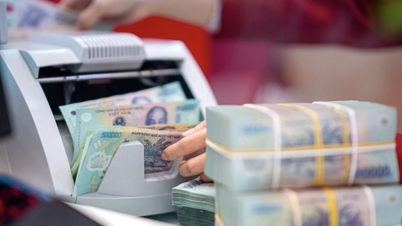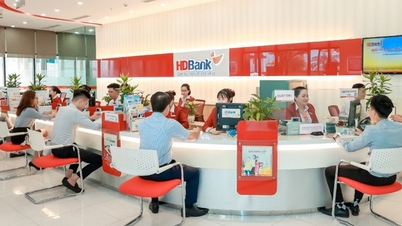Profit support amid narrowing NIM
According to the November 2025 outlook report of Dragon Capital Securities (VDSC), banks will remain the “profit pillar” of the Vietnamese stock market in the fourth quarter of 2025, with expected growth of more than 25% year-on-year. The main driving force comes not only from stable credit, but also from service income, bancassurance and securities investment recovering strongly after the sluggish period of 2023-2024.
For example, at Techcombank , in the third quarter of 2025, total operating income (TOI) increased by 21.2% to VND 14,232 billion, with the non-interest segment alone increasing more than 1.5 times over the same period. Foreign exchange trading and investment securities increased by 816.5% and 172.2%, respectively, bringing in a total of more than VND 1,600 billion. The service and other activities also grew positively, contributing an additional VND 2,842 billion.
mHDBank also recorded non-interest income of VND5,366 billion, up nearly 179% over the same period. Meanwhile,VIB said that non-interest income accounted for more than 19% of total operating income in the first 9 months of the year, mainly coming from credit card services, international money transfers, insurance and digital banking utilities.
 |
| In the context of net interest margin (NIM) being under pressure due to increasing mobilization costs and fierce credit competition, commercial banks are promoting the strategy of diversifying revenue sources, especially non-interest income. |
Even small banks are catching up with the trend. KienlongBank is restructuring its revenue sources towards sustainability, focusing on services and non-credit; its profit from securities investment has tripled over the same period.
In the state-owned commercial banking sector, VietinBank's net profit from trading securities reached VND667 billion, more than eight times higher than in 2024. Vietcombank also recorded a non-interest business segment contributing VND3,395 billion, up 4.2%...
According to bank representatives, banks are currently promoting non-credit activities, on the one hand to diversify revenue sources, gradually reduce dependence on credit to move towards sustainable growth; on the other hand, to disperse risks, especially bad debt risks in the context of the economy still facing many difficulties due to the impact of the global market.
Diversifying revenue sources - an inevitable direction
According to SSI Research, in the first 9 months of 2025, NIM continued to narrow due to rising funding costs and fierce credit competition, but non-interest income accelerated strongly, helping banks maintain profit growth. Revenue from foreign exchange transactions increased by 23%, while profits from securities increased 33 times, mainly thanks to the contribution of securities companies under banks such as TCBS (Techcombank) and VPBankS (VPBank).
Mr. Le Khanh Tung, Head of Financial Services Industry Research at HSC, analyzed that in the past 1-3 years, the profit contribution rate from securities companies under banks has been increasing. Typical examples are Techcombank (TCBS) and VPBank (VPBankS), where securities companies contribute 16-21% of the bank's after-tax profit (as of the first half of 2025).
Not stopping there, many banks are expanding their investment activities beyond traditional credit. PGBank has approved the policy of purchasing shares of securities, insurance or fund management companies to become subsidiaries or affiliates. Sacombank plans to invest up to VND1,500 billion to own more than 50% of a securities company. In parallel, new policies such as Resolution 05 on piloting the digital asset market and the Digital Industry Law are opening up a new growth space. About 10 securities companies and 3 large private banks have pioneered in participating in the digital asset market, with a transaction volume that can reach 700 million USD/day if the pilot is successful, equivalent to 50% of the current stock market value.
In addition, in the strategy of expanding revenue sources, digital transformation continues to play a central role. Mr. Vu Thanh Trung, Vice Chairman of MB Board of Directors, said: “Key digital platforms such as App MBBank, BIZ MBBank and Banking-as-a-Service (BAAS) have strongly contributed to customer growth, CASA and revenue”.
For VIB, strong investment in digital banking and the credit card ecosystem has helped the bank reach more than 1 million cards in circulation, with total spending of VND104,000 billion after 9 months, up 15% over the same period. Along with bill payment, money transfer, and insurance products, digital platforms are becoming a new "revenue engine". Thanks to digital transformation and service diversification, banks are gradually reducing their dependence on credit, while increasing their resilience to economic fluctuations.
VDSC assesses that the fourth quarter of 2025 will be a “test of endurance” for the banking industry. Banks with high CASA ratios, diversified credit portfolios and sustainable growth strategies will continue to maintain stable growth momentum, while the group dependent on traditional credit will face profit pressure in the first half of 2026.
According to experts, increasing non-interest income is no longer an “option”, but has become a vital strategy to help banks reduce cyclical risks, strengthen financial capacity and improve operational efficiency. When the digital asset market, bancassurance, gold trading... are expanded, along with the strong wave of digital transformation, the profit picture of the banking industry promises to be more colorful and sustainable.
Source: https://thoibaonganhang.vn/ngan-hang-tang-thu-ngoai-lai-huong-di-chien-luoc-cho-tang-truong-ben-vung-173361.html



































































































![Dong Nai OCOP transformation: [Article 4] Reaching national standard products](https://vphoto.vietnam.vn/thumb/402x226/vietnam/resource/IMAGE/2025/11/11/1762825820379_4702-cac-san-pham-trai-cay-chung-nhan-ocop-nongnghiep-174649.jpeg)


![Dong Nai OCOP transition: [Article 3] Linking tourism with OCOP product consumption](https://vphoto.vietnam.vn/thumb/402x226/vietnam/resource/IMAGE/2025/11/10/1762739199309_1324-2740-7_n-162543_981.jpeg)






Comment (0)